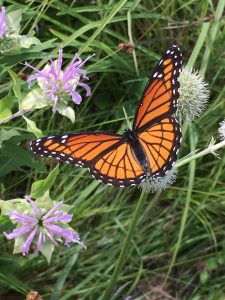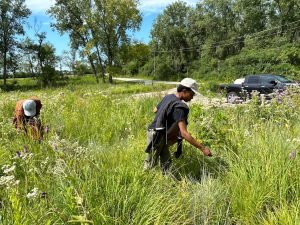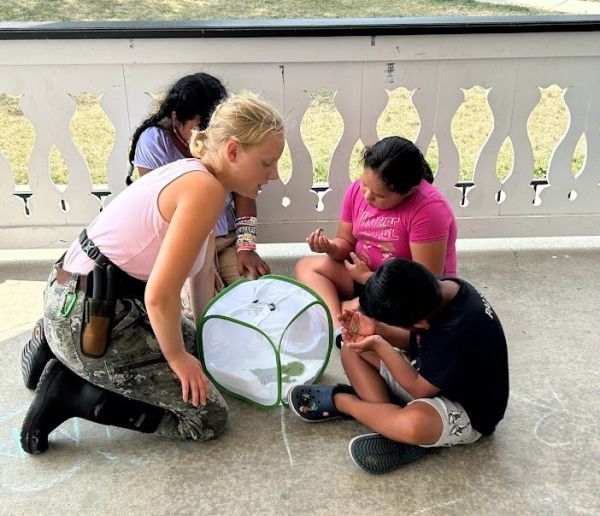
A Bat, a Food Forest and Hatching Caterpillars – CLIP Week 8
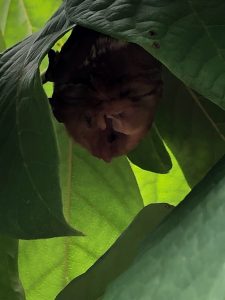
Monday we spent the day with Jack and Judy Speer at Small Waters Education in Harvard, where we were introduced to the world of permaculture and food forests! They treated us to some Pawpaw muffins and showed us inside and around their home. Outside they showed us their permaculture setup, and their rain garden was pretty neat! We then helped them garden by planting some plugs. We learned a new planting technique that included laying down cardboard, wetting it, cutting the cardboard open and planting the plug, mulching over top, and finishing it off with some watering.
For lunch, Jack and Judy generously fed us some yummy rhubarb pie with ice cream, currant juice and sunchoke pickles. After our filling lunch, we continued in the garden where we spotted a bat in the Pawpaw tree! He was hanging out taking a nap with the Pawpaw fruits, blending right in. To finish the day we played a game and ‘built’ our own little permaculture homestead using the techniques they taught us. I loved learning how we can grow our own food right in our backyards while also respecting the land and providing a diverse native landscape as indigenous people have done.
Tuesday, Ders Anderson, TLC board member, taught us about glaciers and how they shaped our landscape and soil and how that plays a role in restoration. He showed us some cool visuals, including a map with soil types! Afterward, he brought us out to Yonder Prairie to a site on a knoll that Native Americans may have once occupied. Armed with some shovels, sifters and gloves, we sifted through soil to find artifacts. With optimism we found some possible spear points and chips of chert rock which were often used to make them.
Later in the day we were set to teach the Youth and Family Center of McHenry County kids about pollinators by doing a Bingo scavenger hunt at Boloria Meadows, but unfortunately plans changed at the last minute. In spite of the prompt change in plans, we managed to pull off a Plan B. We took pollinator plant samples to the kids and passed them around while teaching them about the different pollinator plants.
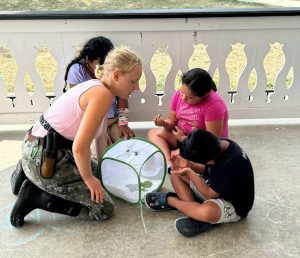 Leah brought some cool monarch caterpillars and chrysalises for the kids to see, and they were definitely fascinated by them. We also showed them how to make a butterfly out of pipe cleaners afterward. When we were all done, they got stickers and bingo cards with pollinator plants to play with at home! Although environmental education is not a path I want to take in my career, it warms the heart to see kids spark an interest in nature, which makes the future seem a little bit brighter.
Leah brought some cool monarch caterpillars and chrysalises for the kids to see, and they were definitely fascinated by them. We also showed them how to make a butterfly out of pipe cleaners afterward. When we were all done, they got stickers and bingo cards with pollinator plants to play with at home! Although environmental education is not a path I want to take in my career, it warms the heart to see kids spark an interest in nature, which makes the future seem a little bit brighter.


On Wednesday, we faced unideal weather conditions which resulted in a change of plans for the day. Instead of backpack spraying, we pulled parsnip at Hennen for a short period before being rained on. Because of the rain, we decided to do paperwork and work on our research project. We planted the rudbeckia at the beginning of the summer, and although there has been growth, the results are inconclusive at this stage. In the afternoon the CLIPsters monitored Apple Creek to survey the area and record any violations on the easement.
On Thursday, we got an early start. The CLIPsters, led by Jenn, went to Waichunas to spray invasive teasel and purple loosestrife. We also collected heads of the teasel to prevent further dispersal. Next, we participated in a burn lecture to understand the dynamics behind conducting a prescribed burn. Trying to initiate a burn takes a collaborative effort, close communication and the ability to predict wind patterns. Afterward, we participated in a short photography activity and the team got creative to get the best nature shots around Hennen.
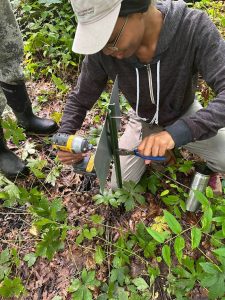
On Friday morning the team put up signs at Thousand Oaks conservation easement. The site is relatively small but still requires work to remove invasive plants, some of which were planted by residents. Educating the public is an important part of restoration to ensure native species can thrive undisturbed. After putting up the signs the next task was collecting Carex sedge at Yonder Prairie in order to create a sedge seed mix. Then, the CLIPsters were able to conduct a grass identification activity with a dichotomous key.
